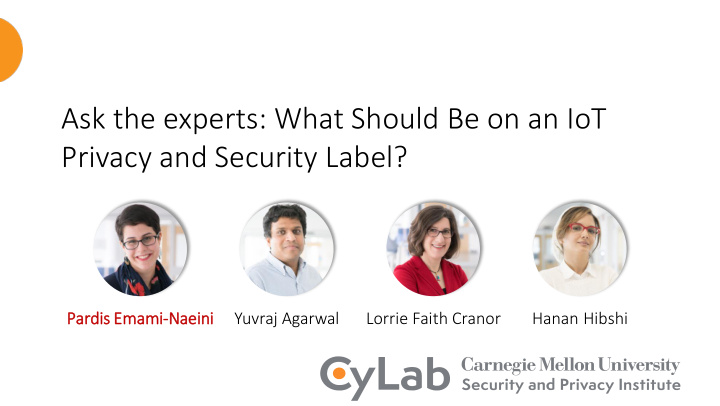



Ask the experts: What Should Be on an IoT Privacy and Security Label? Pardis Emami-Naei eini Yuvraj Agarwal Lorrie Faith Cranor Hanan Hibshi 1
You may have one of these 2
Or even these 3
People are concerned about losing their privacy 4
Smart devices are getting hacked 5
Smart devices are getting hacked Access Co Ac Control 6
IoT companies are sometimes forgetful 7
IoT companies are sometimes forgetful Sensor Type Sens ype 8
There is still a lot that we don’t know 9
There is still a lot that we don’t know Dat Data Shar Sharin ing & & Sel Sellin ing 10
How to effectively provide this information? 11
Positive attitude toward labels • Al Almost all wanted to know about privacy and security before the purchase • Almos ost all were willing to pay a premium for such info (10% - 30%) • Assurance on being protected • Peace of mind Source: Emami-Naeini et al., CHI 2019 12
Policy makers are also excited about IoT labels 13
Policy makers are also excited about IoT labels What should be on IoT privacy and security labels? 14
Three-round Delphi method with 22 experts • Converging opinions without direct confrontation (Dalkey & Helmer, 1963) • Conducted over multiple rounds of interviews and surveys • Controlled feedback loop for convergence 15
Expert recruitment criteria • Computer science or engineering professor in the field of privacy and security • 10+ years of research or practice in privacy, security, or policy • Author of notable books in the field of privacy and security • Active involvement in cybersecurity standardization • Leading a corporate IoT product team 16
One interview and two survey rounds Arguments for and against 47 factors including a factor Interview Survey 1 Survey 2 We conducted a 6-step thematic analysis (Braun & Clarke, 2006) 17
Labels to inform consumers’ purchase behavior What's good about a label is that it empowers the consumer to make a more active decision about cybersecurity rather than just being completely helpless as to what the security of her device might be. The average consumer doesn't have a privacy, security, or a legal department to review this stuff before they buy it. Enterprises do, but consumers do not, so someone's gotta be looking out for consumers and giving the consumers this information. 18
Other perceived values of the label • Increasing accountability and transparency • Incentivizing manufacturers to compete on privacy and security There is value in forcing the company to write a list down even if the consumer doesn’t understand it. If you said, ‘list your open ports,’ there would be an incentive to make them few. 19
We designed a layered label Primary layer (Jul’19) Secondary layer (Jul’19) 20
Factors to include on the primary layer • Security update lifetime • Type of collected data • Availability of automatic security updates • Availability of default passwords 21
Factors to include on the secondary layer • Retention time • Data inference • Data storage • Special data handling practices for children’s data 22
Semi-structured interviews with IoT consumers • Recruited 15 IoT consumers from the United States • Conducted 1-hour semi-structured interviews • Iteratively improved the design of the label 23
Non-comparative and comparative purchase No Non-comparativ ive Comp Comparativ ive 24
Attitudes toward the design of the label • A few participants preferred single-layer label • Inconvenience of using the phone or scanning the QR code • Feeling of not being shown the whole picture • Most participants expressed positive attitudes toward layered design • More useful information could fit on the layered label • Easily get insight into • Information presented on the primary layer • Manufacturer’s privacy and security practices 25
Label should work for both consumers and experts Labels are both for customers and experts such as tech journalists and consumer advocacy groups. If they see something that is questionable, they will raise it in the public press or will raise it with regulatory authorities. The label is not just for the consumer, but there’s another feedback process that works through experts. 26
Changes we applied to the label • Almost all requested to move data sharing, and data selling to the primary layer • Removed icons used for the automatic security update and default password 27
Primary layer (Jul’19) Primary layer (Sep’19) 28
Primary layer (Sep’19) Secondary layer (Sep’19) 29
How to further improve the label? • Exploring the design elements of the label • Testing the effectiveness of the label in realistic settings 30
Specification document details • 70+ IoT privacy and security references • Taxonomy, consumer explanation, additional information, best practices Pri Prior work is mainl nly focused sed on secur urity of IoT T devices es 31
We designed a tool to generate the label • An interactive form • Download options: • JSON • XML • HTML 32
IoT labels to provide transparency • Designed the label with input from experts • Evaluated the usability of the label • Prepared a specification document for the label • Developed a tool to generate the label Most recent version of the labels, tool, and the specification are available at www.iotsecurityprivacy.org Special thanks to Shreyas Nagare for the tool and website development. 33
Recommend
More recommend